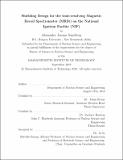Shielding design for the time-resolving Magnetic Recoil Spectrometer (MRSt) on the National Ignition Facility (NIF)
Author(s)
Sandberg, Alexander Jerome.
Download1196204265-MIT.pdf (2.166Mb)
Other Contributors
Massachusetts Institute of Technology. Department of Nuclear Science and Engineering.
Advisor
Johan Frenje and Zachary Hartwig.
Terms of use
Metadata
Show full item recordAbstract
Abstract The National Ignition Facility (NIF) is one of the premier inertial confinement fusion (ICF) experiments active today, with the goal of acheiving ignition in a laboratory for the first time. Multiple diagnostics are needed to generate the scientific data necessary for guiding these experiments at the NIF toward this goal. The time-resolving Magnetic Recoil Spectrometer (MRSt) aims to provide time-resolved measurements of the neutron spectrum, to determine time evolution of ion temperature, areal density, and neutron yield, at a time resolution of 20ps and an energy resolution of 100 keV. This would be the first time-resolved measurement of these quantities, and is crucial to understanding the dynamics of the implosion and possible deviations from optimal performance. The MRSt's unique ability to diagnose the hot-spot formation, fuel assembly, and alpha heating will open a new door to ICF. This work establishes a conceptual shielding design for the MRSt that meets the signal-to-background requirements. The finalized design is composed of 65cm of 30% borated polyethylene shielding for the neutron background, and a 2.5cm layer of tungsten gamma shielding with a 5.5cm layer of shielding on the last 20cm of the pulse dilation drift tube (PDDT) detector. This design reduces the background about 300 times, from 0.12 for the unshielded design to 35 for the finalized shielding design, thus exceeding the requirement of S/B > 5 for the down-scattered-neutron measurement. Neutron background has been reduced nearly to zero, but further gamma reduction could be a future avenue of research, specifically surrounding the graded-Z shielding design.
Description
This electronic version was submitted by the student author. The certified thesis is available in the Institute Archives and Special Collections. Thesis: S.M., Massachusetts Institute of Technology, Department of Nuclear Science and Engineering, 2019 Cataloged from the official PDF of thesis. Includes bibliographical references (pages 49-50).
Date issued
2019Department
Massachusetts Institute of Technology. Department of Nuclear Science and EngineeringPublisher
Massachusetts Institute of Technology
Keywords
Nuclear Science and Engineering.